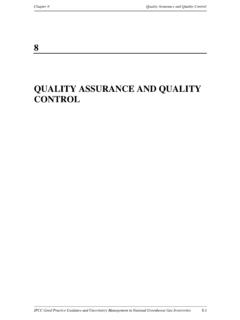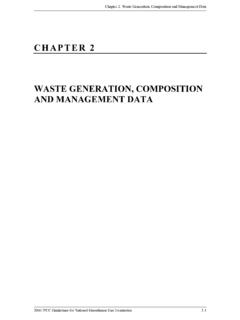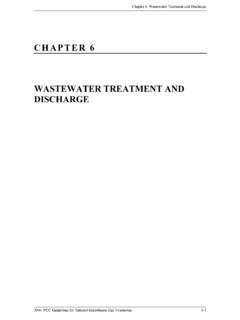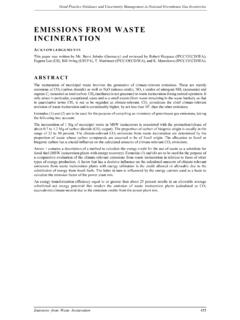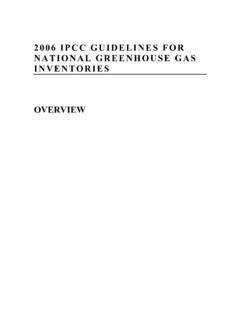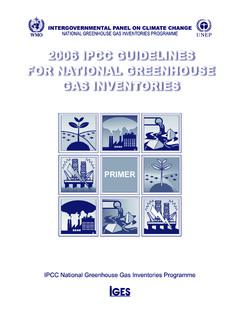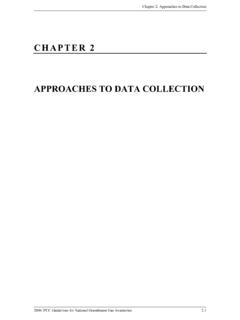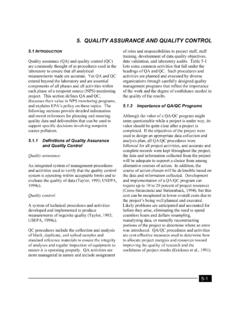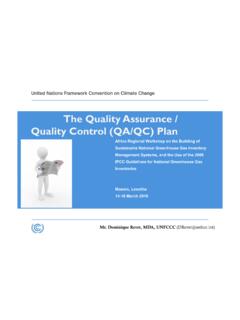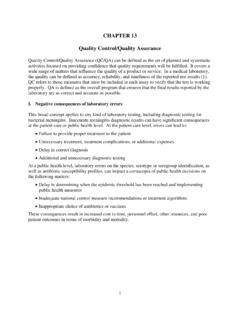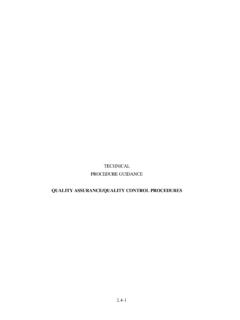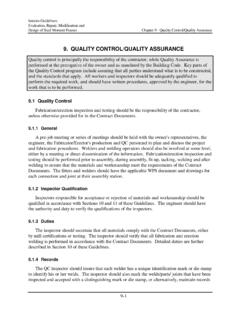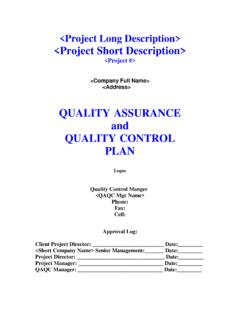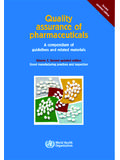Transcription of 8 QUALITY ASSURANCE AND QUALITY CONTROL - IGES
1 Chapter 8 QUALITY ASSURANCE and QUALITY ControlIPCC Good Practice Guidance and Uncertainty Management in National Greenhouse Gas ASSURANCE AND QUALITYCONTROLQ uality ASSURANCE and QUALITY CONTROL Chapter Good Practice Guidance and Uncertainty Management in National Greenhouse Gas InventoriesCO-CHAIRS, EDITORS AND EXPERTSCo-Chairs of the Expert Meeting on Cross-sectoral Methodologies forUncertainty Estimation and Inventory QualityTaka Hiraishi (Japan) and Buruhani Nyenzi (Tanzania)REVIEW EDITORSC arlos M L pez Cabrera (Cuba) and Leo A Meyer (Netherlands)Expert Group: QUALITY ASSURANCE and QUALITY CONTROL (QA/QC)CO-CHAIRSKay Abel (Australia) and Michael Gillenwater (USA)AUTHOR OF BACKGROUND PAPERJoe Mangino (USA)CONTRIBUTORSSal Emmanuel (IPCC-NGGIP/TSU), Jean-Pierre Fontelle (France), Michael Gytarsky (Russia), Art Jaques(Canada), Magezi-Akiiki (Uganda), and Joe Mangino (USA)Chapter 8 QUALITY ASSURANCE and QUALITY ControlIPCC Good Practice Guidance and Uncertainty Management in National Greenhouse Gas QUALITY ASSURANCE AND QUALITY INTRODUCTION.
2 PRACTICAL CONSIDERATIONS IN DEVELOPING QA/QC SYSTEMS .. ELEMENTS OF A QA/QC SYSTEM .. INVENTORY AGENCY .. QA/QC PLAN .. GENERAL QC PROCEDURES (TIER 1).. SOURCE CATERGORY-SPECIFIC QC PROCEDURES (TIER 2) .. data data QC .. of uncertainty QA PROCEDURES .. VERIFICATION OF EMISSIONS DATA .. DOCUMENTATION, ARCHIVING AND REPORTING .. documentation and archiving .. 1 General Inventory Level QC Procedures .. ASSURANCE and QUALITY CONTROL Chapter Good Practice Guidance and Uncertainty Management in National Greenhouse Gas Inventories8 QUALITY ASSURANCE ANDQUALITY INTRODUCTIONAn important goal of IPCC good practice guidance is to support the development of national greenhouse gasinventories that can be readily assessed in terms of QUALITY and completeness.
3 It is good practice to implementquality ASSURANCE and QUALITY CONTROL (QA/QC) procedures in the development of national greenhouse gasinventories to accomplish this guidance establishes good practice consistent with the Revised 1996 IPCC Guidelines for NationalGreenhouse Gas Inventories (IPCC Guidelines). The QA/QC good practice guidance outlined here reflectspracticality, acceptability, cost-effectiveness, existing experience, and the potential for application on a world-wide basis. A QA/QC programme contributes to the objectives of good practice guidance, namely to improvetransparency, consistency, comparability, completeness, and confidence in national inventories of outcomes of the QA/QC process may result in a reassessment of inventory or source category uncertaintyestimates.
4 For example, if data QUALITY is found to be lower than previously thought and this situation cannot berectified in the timeframe of the current inventory, the uncertainty estimates ought to be terms QUALITY CONTROL and QUALITY ASSURANCE are often used incorrectly. The definitions of QC and QA inBox will be used for the purposes of good practice OF QA/QCQuality CONTROL (QC) is a system of routine technical activities, to measure and CONTROL the qualityof the inventory as it is being developed. The QC system is designed to:(i)Provide routine and consistent checks to ensure data integrity, correctness, andcompleteness;(ii)Identify and address errors and omissions;(iii)Document and archive inventory material and record all QC activities include general methods such as accuracy checks on data acquisition andcalculations and the use of approved standardised procedures for emission calculations,measurements, estimating uncertainties, archiving information and reporting.
5 Higher tier QCactivities include technical reviews of source categories, activity and emission factor data, ASSURANCE (QA) activities include a planned system of review procedures conducted bypersonnel not directly involved in the inventory compilation/development process. Reviews,preferably by independent third parties, should be performed upon a finalised inventory followingthe implementation of QC procedures. Reviews verify that data QUALITY objectives were met,ensure that the inventory represents the best possible estimates of emissions and sinks given thecurrent state of scientific knowledge and data available, and support the effectiveness of the implementing QA/QC activities, it is necessary to determine which techniques should be used, and whereand when they will be applied.
6 There are technical and practical considerations in making these decisions. Thetechnical considerations related to the various QA/QC techniques are discussed in general in this chapter, andspecific applications to source categories are described in the source category-specific good practice guidance inChapters 2 to 5. The practical considerations involve assessing national circumstances such as availableresources and expertise and the particular characteristics of the inventory. The level of QA/QC activities shouldbe compatible with the methods or tiers used to estimate emissions for particular source categories. In addition,resources should be focused on priority areas, such as the key source categories (as described in Chapter 7,Chapter 8 QUALITY ASSURANCE and QUALITY ControlIPCC Good Practice Guidance and Uncertainty Management in National Greenhouse Gas Choice and Recalculation, , Determining National Key Source Categories) and sourcecategories where changes have occurred in methods or data acquisition since the last inventory PRACTICAL CONSIDERATIONS INDEVELOPING QA/QC SYSTEMSI mplementing QA/QC procedures requires resources, expertise and time.
7 In developing any QA/QC system, it isexpected that judgements will need to be made on the following: Resources allocated to QC for different source categories and the compilation process; Time allocated to conduct the checks and reviews of emissions estimates; Availability and access to information on activity data and emission factors, including data QUALITY ; Procedures to ensure confidentiality of inventory and source category information, when required; Requirements for archiving information; Frequency of QA/QC checks on different parts of the inventory; The level of QC appropriate for each source category; Whether increased effort on QC will result in improved emissions estimates and reduced uncertainties; Whether sufficient expertise is available to conduct the checks and practice, the QA/QC system is only part of the inventory development process and inventory agencies do nothave unlimited resources.
8 QUALITY CONTROL requirements, improved accuracy and reduced uncertainty need to bebalanced against requirements for timeliness and cost effectiveness. A good practice system seeks to achievethat balance and to enable continuous improvement of inventory the QA/QC system, good practice provides for greater effort for key source categories and for thosesource categories where data and methodological changes have recently occurred, than for other sourcecategories. It is unlikely that inventory agencies will have sufficient resources to conduct all the QA/QCprocedures outlined in this chapter on all source categories. In addition, it is not necessary to conduct all of theseprocedures every year. For example, data collection processes conducted by national statistical agencies are notlikely to change significantly from one year to the next.
9 Once the inventory agency has identified what qualitycontrols are in place, assessed the uncertainty of that data, and documented the details for future inventoryreference, it is unnecessary to revisit this aspect of the QC procedure every year. However, it is good practice tocheck the validity of this information periodically as changes in sample size, methods of collection, or frequencyof data collection may occur. The optimal frequency of such checks will depend on national focusing QA/QC activities on key source categories will lead to the most significant improvements in theoverall inventory estimates, it is good practice to plan to conduct at least the general procedures outlined inSection , General QC Procedures (Tier 1), on all parts of the inventory over a period of time.
10 Some sourcecategories may require more frequent QA/QC than others because of their significance to the total inventoryestimates, contribution to trends in emissions over time or changes in data or characteristics of the sourcecategory, including the level of uncertainty. For example, if technological advancements occur in an industrialsource category, it is good practice to conduct a thorough QC check of the data sources and the compilationprocess to ensure that the inventory methods remain is recognised that resource requirements will be higher in the initial stages of implementing any QA/QCsystem than in later years. As capacity to conduct QA/QC procedures develops in the inventory agency and inother associated organisations, improvements in efficiency should be QC procedures outlined in Table , Tier 1 General Inventory Level QC Procedures, and a peer reviewof the inventory estimates are considered minimal QA/QC activities for all inventory compilations.
